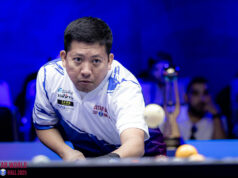FIDE Candidates Tournament
2018 Berlin, Germany
March 10-28, 2018
Standings (9 of 14)
1. Fabiano Caruana USA 2784, 6.0/9
2. Shakhriyar Mamedyarov AZE 2809, 5.5/9
3. Alexander Grischuk RUS 2767, 5.0/9
4-5. Ding Liren CHN 2769, Sergey Karjakin RUS 2763, 4.5/9
6-8. Levon Aronian ARM 2794, Wesley So USA 2799, Vladimir Kramnik RUS 2800, 3.5/9
Average Rating: 2786 Category 22
Time Control: 100 minutes for the first 40 moves, then 50 minutes for the next 20 moves followed by 15 minutes play-to-finish with 30 seconds added to your clock after every move starting move 1.
Fabiano Caruana is now in the solo lead with 5 rounds to go in the Berlin Candidates’ tournament. There is a rest day after every threerounds and Caruana has won games 1 (Wesley So), 4 (Kramnik) and 7 (Aronian), all of his games coming from a break. He was a bit lucky to defeat Kramnik but on the whole his quality of play is of a high standard and his openings solid plus aggressive. The odds are on Fabi to finally win the Candidates. We shouldn’t be too confident though — two years ago in the Moscow Candidates the Italian-American GM was also in the lead three rounds before the end. If you will recall Karjakin won in round 11 to tie for the lead, and then defeated Caruana in the decisive last round to win the tournament.
Mamedyarov is just half a point behind. Apart from beating Karjakin in round 1 and Kramnik in round 6 “Shakh” has taken several short draws and it looks like he is biding his time for a final sprint at the finish line.
Last Tuesday I promised to show you today the Kramnik brilliancy over Levon Aronian in the 3rd round and that is exactly what I am going to do. If you will recall Vladimir Kramnik started out with 2.5/3 with wins against Alexander Grischuk and Levon Aronian and a well-fought draw with Sergey Karjakin; it looked like he was in very good shape to contend for first in this Candidates’ tournament. Remember, whoever wins this tournament will be challenging for the world title this November against Magnus Carlsen for really big bucks.
The next three rounds was a bit of a disaster for him — 0.5/3 with losses against Caruana and Mamedyarov plus a draw with Wesley So. This was very irksome as he was winning against Caruana and had a hallucination vs Mamedyarov in a drawn game.
But let us concentrate on his game with Aronian. This early it is already a contender for Game-of-the-Year. There is a bit of déjà vu here too — in a press conference before the tournament started Kramnik had remarked that one of his contributions to opening theory, his advocacy of the Berlin Defense, might have motivated the Berlin organizers to invite him to this tournament as the wild card entry. Many of his opponents nowadays do not allow him to play the Berlin as even Garry Kasparov during their 2000 World Championship Match could not crack this so-called “Berlin Wall.” Well, in the following game he got his chance to play the Berlin!
The pianist Francesco Tristano was the special guest of the organizers for round 3 and he was invited to make the ceremonial first move. The Baroque Pianist approached the table of Aronian and Kramnik and played 1.e4. Now, Aronian plays 1.d4 or 1.c4 80% of the time and the expectation was that Levon would take that move back and play 1.d4, but he let it stand! Kramnik was delighted to see 1.e4 and looked at Aronian to ensure the correctness of the move. After receiving a slight nod to indicate the affirmative the game began.
Aronian, Levon (2794) — Kramnik, Vladimir (2800) [C65]
FIDE Candidates 2018 Berlin GER (3.4), 12.03.2018
1.e4 e5 2.Nf3 Nc6 3.Bb5 Nf6 4.d3
Back in 2012 Aronian and Kramnik played a 6-game match dubbed “Zurich Chess Challenge.” It ultimately ended in a tie, 1 win each for the two players and 4 draws.
In all of which three white games of the match Aronian played 1.e4 and we had a Berlin Defense on the board in short order. After failing to make any impression at all with 1.e4 e5 2.Nf3 Nc6 3.Bb5 Nf6 4.0–0 Nxe4 5.d4 Nd6 6.Bxc6 dxc6 7.dxe5 Nf5 8.Qxd8+ Kxd8, in the crucial 6th and final game Aronian changed his approach, avoided simplification and played 4.d3.
4…Bc5 5.Bxc6
The 6th and final game we were talking about continued 5.Nbd2 d6 6.c3 0–0 7.0–0 Ne7 8.h3 Ng6 9.Re1 c6 10.Ba4 Re8 11.d4 Bb6 12.Bc2 h6 13.a4!? Be6 14.Nf1 exd4!? 15.Nxd4 Bd7 16.f4 White had a good game although it ultimately ended in a draw. Aronian,L (2820)-Kramnik,V (2801) Zuerich 2012 (game 6) 1/2 43.
5…dxc6 6.0–0
[6.Nxe5?? Qd4]
6…Qe7
The two main moves here are 6…Nd7 and the text. Kramnik prefers to put his queen on e7 — He wants to leave the diagonal of his white-squared bishop open so he can play …Bg4.
7.h3
Seeing that his opponent intends to play …Bg4 Aronian immediately removes that possibility. Kramnik: “The thing is, Black wants … Bg4 after Nbd2. I always considered 7.h3 as a very serious move and I actually spent a lot of time analyzing it, and it was not so easy. But then, a couple of years ago, I found this very strong resource.” <D>
POSITION AFTER 7.H3
7…Rg8!
Kramnik: “I think it’s just a killer. Black is just better after Rg8 and I was waiting for my moment to use it and of course it came at a most unexpected moment. In Candidates, against Levon, who doesn’t play e4. Rg8 is a very strong move here.”
8.Kh1 Nh5
This is the only thing Kramnik remembers from all his previous analysis work. From now on he is playing on his own.
9.c3?!
Good idea, trying to open the center with black’s king still uncastled, but with the benefit of hindsight this seems too slow. Better is 9.Nc3 (this was Aronian’s suggestion immediately after the game) 9…g5 10.Nxe5 g4 11.d4 Bd6 White is still alive and fighting.
9…g5 10.Nxe5 g4
[Not 10…Qxe5? 11.d4 Qe7 12.Qxh5 it is White who is better]
11.d4
No choice. If 11.Nxg4 he is mated by 11…Bxg4 12.hxg4 Qh4+ 13.Kg1 Ng3 and 14…Qh1 mate.
11…Bd6 12.g3
Still not possible is 12.Nxg4 Bxg4 13.hxg4 Qh4+ 14.Kg1 Qh2#
12…Bxe5 13.dxe5 Qxe5 14.Qd4 Qe7 15.h4 c5 16.Qc4
Aronian: “A terrible blunder; I forgot that Black is threatening …f5.” According to Kramnik White should play 16.Qd3 where Black is still much better but White still has a chance to resist.
16…Be6 17.Qb5+ c6 18.Qa4?
White’s best is still 18.Qd3 although 18…Rd8 19.Qe3 Bc4 20.Rg1 puts him under great pressure.
18…f5!
The reason why White should have preferred Qd3.
19.Bg5
Played after long thought. The point is that 19.exf5 Nxg3+! 20.fxg3 (20.Kg2 Nxf5) 20…Bd5+ 21.Kg1 Qe2 22.Rf2 Qe1+ 23.Rf1 Qxg3#.
19…Rxg5! 20.hxg5 f4! 21.Qd1
There is no salvation:
21.gxf4 Nxf4 22.Qc2 Qxg5;
21.Kg2 Qxg5 White’s king cannot survive
21…Rd8 22.Qc1
[22.Qe2 Qxg5 23.Nd2 fxg3 24.Kg1 (24.f4 Nxf4) 24…Rxd2 is obviously no good]
22…fxg3 23.Na3 Rd3 24.Rd1 Bd5!
Blow follows blow.
25.f3
Mate cannot be prevented:
25.Rxd3 Qxe4+;
25.exd5 Qe4+ 26.Kg1 gxf2+ 27.Kxf2 Rh3 28.Re1 g3+ 29.Kg1 Rh1#.
25…gxf3 26.exd5
[26.Rxd3 Qxe4 27.Re3 f2+ 28.Rxe4+ Bxe4# would have been a beautiful way to end this game.]
26…Qe2 27.Re1 g2+ 0–1
After 27…g2+ Aronian resigns rather than be mated on the board:
28.Kh2 g1Q+ 29.Kxg1 f2+ 30.Kh1 (30.Kg2 fxe1Q#) 30…Rh3+ 31.Kg2 f1Q#
28.Kg1 f2+ 29.Kh2 g1Q+ 30.Rxg1 f1B+ (just for fun) 31.Kh1 Rh3#
Bobby Ang is a founding member of the National Chess Federation of the Philippines and its first Executive Director. A Certified Public Accountant, he taught accounting in the University of Santo Tomas for 25 years and is currently Chief Audit Executive of the Equicom Group of Companies.



